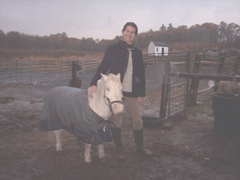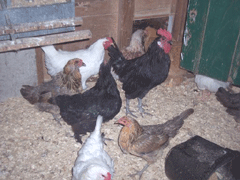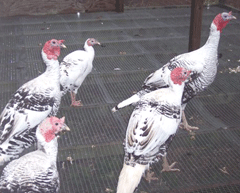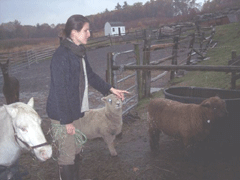E-I-E-I-Endangered?
Air Date: Week of November 23, 2007

Jennifer Cermak with Sugar the mini horse (Photo: Bruce Gellerman)
If Old MacDonald still had his farm he might have animals like the ones Jennifer Cermak raises. Cermak, a fourth generation farmer, raises rare and endangered barnyard animals. LOE's Bruce Gellerman toured Cermak's Berlin Farms, just outside Boston, for a firsthand look at Sumatra and Sussex chickens and royal palm turkeys.
Transcript
[ROOSTER CROWS]
CURWOOD: The sound is familiar, but the site and situation are a bit unusual. Welcome to Berlin Farms. Located about 40 miles west of Boston, at the edge of suburbia, this is no ordinary farm. Here, for the past two years, Jennifer Cermak has been saving endangered farm animals from extinction. These are not your run-of-the-mill chickens, horses, turkeys, rabbits and sheep, but animals with long heritages that are small in numbers.
Jennifer Cermak is a fourth generation farmer with a PhD in the science of memory and development. She bought Berlin farms and converted it into a place to protect the rare animals. She also turned the farmhouse into a restaurant and a farm stand where she sells local food and products. Living On Earth’s Bruce Gellerman visited Jennifer Cermak down on the farm.
CERMAK: Believe it or not but there are a lot of endangered barnyard animals because there are so few small farms in existence. There are a lot of commercial farms that will carry one breed, for example, one breed of New Holland turkey but because there was a great breed diversity in the mid to late 1800s, we’ve lost that breed diversity as we’ve gone to large, commercial farms.
GELLERMAN: So you’re protecting endangered farm animals?
CERMAK: Yes. I think most people think in terms of endangered rainforests, endangered African wildlife, and they don’t realize that this is a problem in their own backyard.
GELLERMAN: How big a problem? And, I haven’t noticed it, to be honest with you.
CERMAK: Sure. And that’s because most people don’t live in an agricultural zone and have the hands-on access and experience to what’s going on in those farms. For example, one of our chickens—there’s probably only 500 left in the United States, which puts them on a critical list.
GELLERMAN: What kind of chickens?
CERMAK: They’re called Sumatra. They’re a big—or a smaller, very fancy-looking, black chicken.

Fewer than 500 of these rare Sumatra chickens exist in the country today. (Photo: Bruce Gellerman)
CERMAK: Absolutely.
[SOUND OF FOOTSTEPS AND DOOR OPENING]
CERMAK: We’ll have to see who’ll come out. Because of the rain, I think everyone wants to stay indoors dry. We’ll go fish him out.
[DOOR OPENS]
GELLERMAN: Whoa, look at those birds!
CERMAK: So if you see the big fancy black ones with the long tails—the three of them. Those are Sumatras. And right here we have a Speckled Sussex and a Rhode Island Red.
GELLERMAN: The Sussex—is it rare?
CERMAK: Yes, they are. All of these are on watch lists, either critical or endangered, based on their numbers in the United States.
GELLERMAN: Where do you get them from?
CERMAK: So you have to buy birds—in the state of Massachusetts—from people that have licensed approval. You can’t just ship birds across state lines—
[ROOSTER CROWS]
CERMAK: -- from non-accredited hatcheries.
GELLERMAN: What are you going to do with them? Are you going to breed them or am I going to have it in a potpie someday?
CERMAK: (laughs) Right. So, this is a no-kill farm. So what we do is sell the chicken eggs. So we sell chicken and turkey eggs. And we also use it in our baking. We have a brunch service Monday through—uh, Saturday and Sunday. And we use the eggs in omelets and pies, things like that.
[ROOSTER CROWS]
GELLERMAN: They really do that.
CERMAK: They really do. And they start at about 3 o’clock in the morning. So I think one starts and the others start challenging it and it goes from there all day. (Laughs) So you don’t want to have very close neighbors.
GELLERMAN: So what are these animals here? I’ve never seen—what is it a turkey or something?

Jennifer's royal palm turkeys. Only around 10,000 of this breed exist in the country. (Photo: Bruce Gellerman)
GELLERMAN: And what do you do with them?
CERMAK: We use their eggs. They have a really nice, big egg. It’s great for baking. It tastes like a chicken egg. You can’t really see but they have a—if they turn around, they have a beautiful blue face and an orangish red head. And they’re very docile. I mean, one thing you find out quickly when you’re raising different kinds of birds and chicken—is that some are inherently a little nastier than others and some are just sweet as pie. These guys are really friendly. I hand raised them. Hi guys!
[TURKEYS CHIRP]
CERMAK: So typically a commercial farm might raise all one bird, like a New Holland. So what we’ll be doing next season is bringing in most likely a chocolate turkey, which is on a critical list. So, because we’re not required to provide a thousand turkeys for the holiday season for table, we have the ability to bring in a few rare turkeys and raise them and breed them and let them live out their life expectancies and provide eggs.
GELLERMAN: You know, you’re solving a problem I never knew we had.
CERMAK: Yes, I think a lot of people aren’t exposed to agriculture like they were before. One of the difficulties in running a farm like this is being able to find people that have the know-how, that aren’t afraid of chickens, that know how to take care of horses.
GELLERMAN: So they’re endangered, too.
CERMAK: Yes, people that have farming experience, that know when an animal is sick or okay, it’s very difficult to find. So, I’m going to show you the Southdowns. The Southdown sheep are recovering, which is also fantastic. They were an endangered breed as well. We’re just going to grab some hay and go feed them. And you’ll find what’s neat about them is they’re extremely docile and part of what makes your farming easier if you’re dealing with animals that aren’t going to give you any trouble, that aren’t going to ram you when you’ve turned around and aren’t looking. That’s quite unpleasant.

Jennifer with her Southdown sheep. (Photo: Bruce Gellerman)
CERMAK: (laughs) Sorry.
GELLERMAN: Oh my!
CERMAK: That’s right. This is the menagerie.
GELLERMAN: Holy cow. That’s—an alpaca?
CERMAK: That’s an alpaca and his—he’s a South American animal originally and he’s not endangered. He keeps the sheep safe. So, coyotes don’t like alpacas. We have a ton of coyotes here. So the alpaca guards the herd.
[GATE OPENS]
CERMAK: You’re a good boy!
GELLERMAN: So what will you do with the sheep?
CERAK: So we’re going to breed them as well.
GELLERMAN: Jennifer, if you could have one pair of animals that is endangered, what would it be?
CERMAK: Oh um—
[BELL RINGS]
CERMAK: I would have to say, and this is just because I was one of those schoolgirls that took lessons out of elementary school, it would have to be the horses. Um, I just love—there are endangered horses as well. We have a Freisian that is. But you know, I love to ride. So for me it would serve a dual purpose—I’d be able to ride and be helping this cause as well.
GELLERMAN: So is this a lifelong dream for you or you just kind of woke up one day and said ‘you know, I’ve got to go save endangered farm animals?’

Bella the pot-bellied pig at Berlin Farms. (Photo: Bruce Gellerman)
So the other thing I really didn’t know about being a farmer is you need to be a mechanic, and that’s a little hard. So you have to be able to fix your own tractor and I haven’t learned how to do that yet, so that’s my biggest trouble because that thing breaks down every five minutes. So um, what you’re looking at is a Polish. He doesn’t have a lot of meat on him. He’s a smaller chicken.
GELLERMAN: He looks like almost, what, I don’t know what.
CERMAK: He’s very fancy looking. And you can see, which is probably why he is endangered, he’s not one of these big-breasted roasters that falls over on itself. And you can see these birds are a little more delicate than you’d expect at table.

Jennifer Cermak with Sugar the mini horse (Photo: Bruce Gellerman)
CERMAK: He’s called a Polish.
GELLERMAN: How many of those are there in this country, do you know?
CERMAK: Um, they are on a watch list. Maybe about 5,000 if I had to guess.
GELLERMAN: Now, the USDA—
CERMAK: Yes.
GELLERMAN: Does it categorize farm animals as endangered?
CERMAK: Not that I’m aware of. I believe the wildlife and fisheries organization categorizes native animals and most of these breeds were brought over from England, Europe, Asia, 1800s mid to late and that’s when the breed registries were started and we started counting how many of a particular breed that we had. And obviously at that time most people had chickens in their backyard and did maintain some amount of agriculture so you could have breed diversity. And now big commercial farms aren’t interested in maintaining these breeds, obviously because of the economics aren’t there for them. Um, but it is important to maintain breed diversity and to keep not only numbers of a particular bird but flocks of a bird in different areas should a disease break out. That there are a number of breeding areas.
So this is really a treat that this can stay open to the public with people visiting and seeing these kinds of birds. Obviously, with a big, commercial facility you might not want someone off the street walking in and carrying you don’t know what on their shoes, and making a large population of birds sick. I mean, some of these hatcheries have 300,000 birds.
GELLERMAN: So you’re kind of part of agrotourism.
CERMAK: That’s right. That’s right. I’m not sure how many people have heard that phrase but people have very little exposure to agriculture and now that’s a new business—agrotourism. Showing people how to farm, giving them access to animals they’re not allowed to have in their neighborhoods, and providing them a large space that’s serene, where they can come with their families and enjoy themselves.
What’s challenging as an owner of one of these farms is the liability. You’re taking families that may or may not have experience with animals, that may or may not be doing different things that put themselves at risk, whether it’s in the simplest form that they don’t know that they’re looking at a chicken, when they see these chickens. And it’s great you can tell them what they’re looking at. And in other times you just get people that just don’t have judgment and—
GELLERMAN: It’s not wrapped in plastic.
CERMAK: (laughs) That’s right. That’s right. So, these guys have beaks and they peck and they have feelings. And the reason, I believe, that these guys are not very aggressive is because we’re very gentle with them.
[ROOSTER CROWS, CELL PHONE RINGS]
GELLERMAN: What is that?
CERMAK: That’s my phone.
GELLERMAN: Oh, so you do have some modern technology here.
CERMAK: I do, I have my Blackberry from work so it keeps me on schedule. I probably have some reminder popping up about something. What’s good about some modernization is I can find animals across the country that would be very difficult for me to source. So I can go on the Internet and find a rare breed that’s in Texas, I know that there’s a breeder there and talk to them about purchasing one of the animals. Hey gang! What’s going on? This is Bruce!
GELLERMAN: They don’t seem to care.
CERMAK: They don’t seem to care. They’re very inquisitive. I’ll try to see if there are any eggs, if anyone did any work. Nothing. So, that’s another point with the patience that it requires to care for some of these breeds. If you were a commercial chicken, and you weren’t putting out your egg quota because you’re getting older, you’d get put to market. With us, if they have a slow day and they’re not laying as many eggs, that’s okay.
[FOOTSTEPS]
CERMAK: And we’re back to the cow barn.
GELLERMAN: You have big plans.
CERMAK: We do. We have a lot of work ahead of us. We’ve done our winterizing for the animals so they’re ready for winter. Their jackets are all in or ordered and now we’ll spend the winter making the basement look nice.
[MUSIC PLAYS]
GELLERMAN: You already got your music. Is that Christmas music already?
CERMAK: It is. It is. It’s Louis Armstrong.
[MUSIC: Louis Armstrong “What A Wonderful World” from ‘The Joy Of Christmas Past’ (GRP Records—1994)]
CURWOOD: Oh yeah. Farmer Jennifer Cermak at Berlin Farms in Massachusetts, where she’s saving endangered barnyard animals. She spoke with Living on Earth’s Bruce Gellerman.
Living on Earth wants to hear from you!
Living on Earth
62 Calef Highway, Suite 212
Lee, NH 03861
Telephone: 617-287-4121
E-mail: comments@loe.org
Newsletter [Click here]
Donate to Living on Earth!
Living on Earth is an independent media program and relies entirely on contributions from listeners and institutions supporting public service. Please donate now to preserve an independent environmental voice.
NewsletterLiving on Earth offers a weekly delivery of the show's rundown to your mailbox. Sign up for our newsletter today!
 Sailors For The Sea: Be the change you want to sea.
Sailors For The Sea: Be the change you want to sea.
 The Grantham Foundation for the Protection of the Environment: Committed to protecting and improving the health of the global environment.
The Grantham Foundation for the Protection of the Environment: Committed to protecting and improving the health of the global environment.
 Contribute to Living on Earth and receive, as our gift to you, an archival print of one of Mark Seth Lender's extraordinary wildlife photographs. Follow the link to see Mark's current collection of photographs.
Contribute to Living on Earth and receive, as our gift to you, an archival print of one of Mark Seth Lender's extraordinary wildlife photographs. Follow the link to see Mark's current collection of photographs.
 Buy a signed copy of Mark Seth Lender's book Smeagull the Seagull & support Living on Earth
Buy a signed copy of Mark Seth Lender's book Smeagull the Seagull & support Living on Earth

